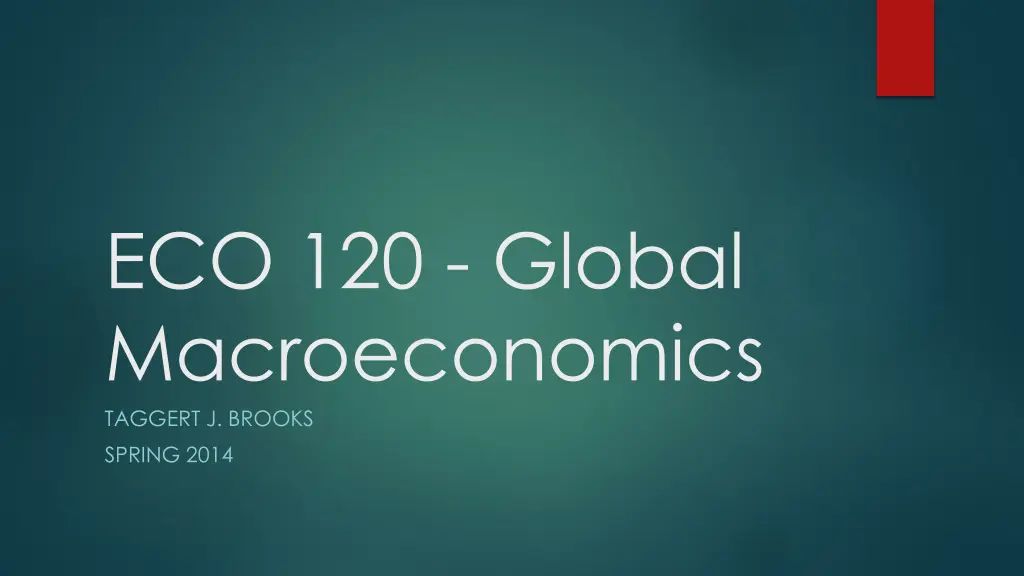
Understanding Bank Operations and Regulations in Global Macroeconomics
Explore the role of banks in global macroeconomics, including concepts like bank reserves, T-accounts, bank runs, and regulations such as deposit insurance and capital requirements. Gain insights into the monetary functions of banks and the implications of bank operations for the economy.
Download Presentation

Please find below an Image/Link to download the presentation.
The content on the website is provided AS IS for your information and personal use only. It may not be sold, licensed, or shared on other websites without obtaining consent from the author. If you encounter any issues during the download, it is possible that the publisher has removed the file from their server.
You are allowed to download the files provided on this website for personal or commercial use, subject to the condition that they are used lawfully. All files are the property of their respective owners.
The content on the website is provided AS IS for your information and personal use only. It may not be sold, licensed, or shared on other websites without obtaining consent from the author.
E N D
Presentation Transcript
ECO 120 - Global Macroeconomics TAGGERT J. BROOKS SPRING 2014
Module 25 BANKING AND MONEY CREATION
The Monetary Role of Banks A bank is a financial intermediary that uses liquid assets in the form of bank deposits to finance the illiquid investments of borrowers. A T-account is a tool for analyzing a business s financial position by showing, in a single table, the business s assets (on the left) and liabilities (on the right).
The Monetary Role of Banks Bank reserves are the currency banks hold in their vaults plus their deposits at the Federal Reserve. The reserve ratio is the fraction of bank deposits that a bank holds as reserves.
Assets and Liabilities of First Street Bank The Federal reserve sets a required reserve ratio. A T-account summarizes a bank s financial position. The bank s assets, $900,000 in outstanding loans to borrowers and reserves of $100,000, are entered on the left side. Its liabilities, $1,000,000 in bank deposits held for depositors, are entered on the right side.
The Problem of Bank Runs A bank run is a phenomenon in which many of a bank s depositors try to withdraw their funds due to fears of a bank failure. Historically, they have often proved contagious, with a run on one bank leading to a loss of faith in other banks, causing additional bank runs.
Bank Regulations Deposit Insurance guarantees that a bank s depositors will be paid even if the bank can t come up with the funds, up to a maximum amount per account. The FDIC currently guarantees the first $250,000 of each account.
Bank Regulations Capital Requirements - regulators require that the owners of banks hold substantially more assets than the value of bank deposits. In practice, banks capital is equal to 7% or more of their assets.
Bank Regulations Reserve Requirements - rules set by the Federal Reserve that determine the minimum reserve ratio for a bank. For example, in the United States, the minimum reserve ratio for checkable bank deposits is 10%. The discount window is an arrangement in which the Federal Reserve stands ready to lend money to banks in trouble.
Determining the Money Supply Effect on the Money Supply of a Deposit at First Street Bank Initial Effect Before Bank Makes New Loans:
Determining the Money Supply Effect on the Money Supply of a Deposit at First Street Bank Effect After Bank Makes New Loans:
Reserves, Bank Deposits, and the Money Multiplier Excess reserves are bank reserves over and above its required reserves. Increase in bank deposits from $1,000 in excess reserves = $1,000 + $1,000 (1 rr) + $1,000 (1 rr)2 + $1,000 (1 rr)3 + . . . This can be simplified to: Increase in bank deposits from $1,000 in excess reserves = $1,000/rr
The Money Multiplier in Reality The monetary base is the sum of currency in circulation and bank reserves. The money multiplier is the ratio of the money supply to the monetary base.
